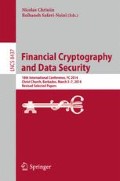Abstract
U-Prove is a credential system that allows users to disclose information about themselves in a minimalistic way. Roughly speaking, in the U-Prove system a user obtains certified cryptographic tokens containing a set of attributes and is able to disclose a subset of his attributes to a verifier, while hiding the undisclosed attributes. In U-prove the actual identity of a token holder is hidden from verifiers, however each token has a static public key (i.e. token pseudonym), which makes a single token traceable, by what we mean that, if a token is presented twice to a verifier, then the verifier knows that it is the same token. We propose an extension to the U-Prove system which enables users to show U-Prove tokens in a blinded form, so even if a single token is presented twice, a verifier is not able to tell whether it is the same token or two distinct tokens. Our proposition is an optional extension, not changing the core of the U-Prove system. A verifier decides whether to use issuer signatures from U-Prove, or the blind certificates from the extension.
This paper was partially supported by grant S30028/I-18 from the Institute of Mathematics and Computer Science of the Wroclaw University of Technology. Part of the work was done by the first author within project 2012-9/4 of the Ventures programme of Foundation for Polish Science, cofinanced from European Union, Regional Development Fund.
Access this chapter
Tax calculation will be finalised at checkout
Purchases are for personal use only
References
Chaum, D.: Security without identification: transaction systems to make big brother obsolete. ACM Commun. 28(10), 1030–1044 (1985)
Brickell, E., Camenisch, J., Chen, L.: Direct anonymous attestation. In: Proceedings of the 11th ACM Conference on Computer and Communications Security. CCS ’04, pp. 132–145. ACM, New York (2004)
Ateniese, G., Camenisch, J., Hohenberger, S., de Medeiros, B.: Practical group signatures without random oracles. Cryptology ePrint Archive, Report 2005/385 (2005). http://eprint.iacr.org/
Bellare, M., Micciancio, D., Warinschi, B.: Foundations of group signatures: formal definitions, simplified requirements, and a construction based on general assumptions. In: Biham, Eli (ed.) EUROCRYPT 2003. LNCS, vol. 2656, pp. 614–629. Springer, Heidelberg (2003)
Boneh, D., Boyen, X., Shacham, H.: Short group signatures. In: Franklin, M. (ed.) CRYPTO 2004. LNCS, vol. 3152, pp. 41–55. Springer, Heidelberg (2004)
Camenisch, J.L., Lysyanskaya, A.: A signature scheme with efficient protocols. In: Cimato, S., Galdi, C., Persiano, G. (eds.) SCN 2002. LNCS, vol. 2576, pp. 268–289. Springer, Heidelberg (2003)
Camenisch, J., Van Herreweghen, E.: Design and implementation of the idemix anonymous credential system. In: Proceedings of the 9th ACM Conference on Computer and Communications Security. CCS ’02, pp. 21–30. ACM, New York (2002)
Paquin, C., Zaverucha, G.: U-prove cryptographic specification v1.1, April 2013. http://research.microsoft.com/pubs/166969/U-ProveCryptographicSpecificationV1.1Revision2.pdf
Verheul, E.R.: Self-blindable credential certificates from the weil pairing. In: Boyd, C. (ed.) ASIACRYPT 2001. LNCS, vol. 2248, pp. 533–551. Springer, Heidelberg (2001)
Okamoto, T.: Provably secure and practical identification schemes and corresponding signature schemes. In: Brickell, E.F. (ed.) CRYPTO 1992. LNCS, vol. 740, pp. 31–53. Springer, Heidelberg (1993)
Author information
Authors and Affiliations
Corresponding author
Editor information
Editors and Affiliations
Rights and permissions
Copyright information
© 2014 International Financial Cryptography Association
About this paper
Cite this paper
Hanzlik, L., Kluczniak, K. (2014). A Short Paper on How to Improve U-Prove Using Self-Blindable Certificates. In: Christin, N., Safavi-Naini, R. (eds) Financial Cryptography and Data Security. FC 2014. Lecture Notes in Computer Science(), vol 8437. Springer, Berlin, Heidelberg. https://doi.org/10.1007/978-3-662-45472-5_17
Download citation
DOI: https://doi.org/10.1007/978-3-662-45472-5_17
Published:
Publisher Name: Springer, Berlin, Heidelberg
Print ISBN: 978-3-662-45471-8
Online ISBN: 978-3-662-45472-5
eBook Packages: Computer ScienceComputer Science (R0)

